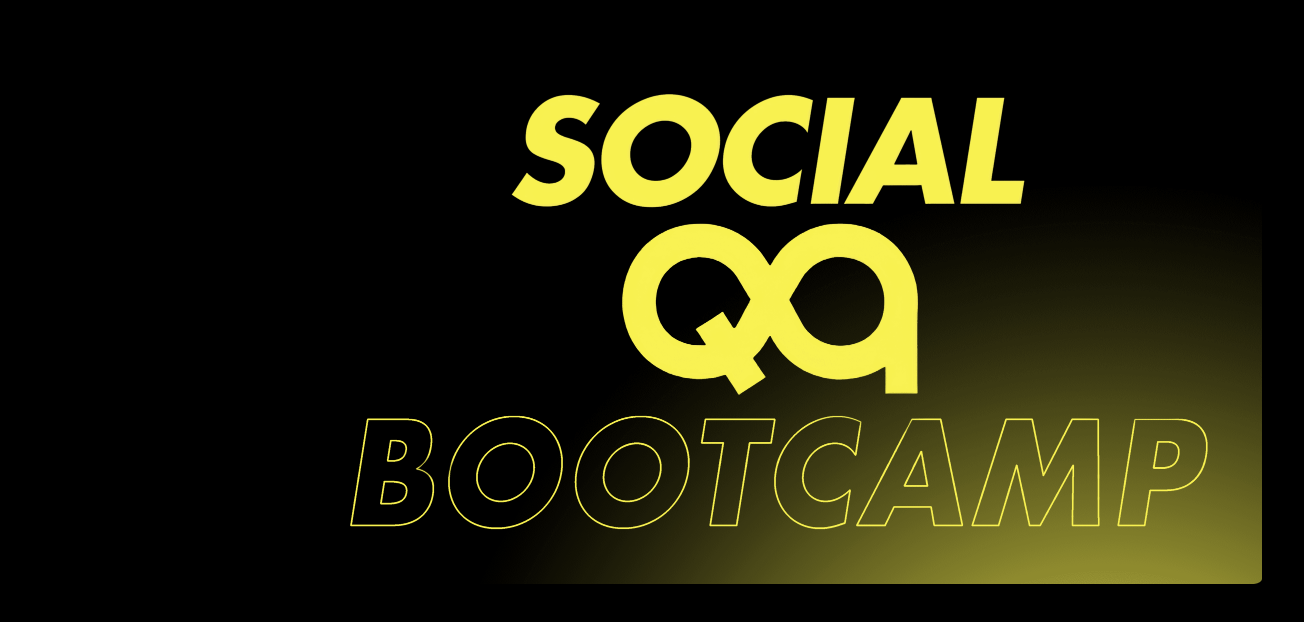Creating my first QA Bootcamp
 Steven Boutcher
Steven Boutcher
Me & Teaching: a complicated relationship
Abandoning the public school system
I always wanted to be a teacher.
Well, not always, but for over a decade now, that’s a career path I’ve been drawn to.
My degree was in Spanish Education: I was studying to be a high school Spanish teacher.
That obviously worked out.

At some point during college, I decided it wasn’t going to be a fit.
I had 4 main beefs with becoming a public school teacher:
I’d have to wrangle attention before I could teach anything: most kids don’t wanna be there, and I’m not skilled at classroom management (nor motivated to be skilled at it)
I hated the concept of “teaching to the C-level student”. I wanted to truly individualize education for each student
The pay: most teachers never make it past $100,000/year, and I wanted to travel the world and eat at nice restaurants without having to stress about money
The hours: teachers tend to start early and end late, and often take their work home with them
I still wanted to teach, but I knew public school wasn’t where I was going to do it.
Didn’t figure this out until it was too late to change majors, so I opted out of my student teaching semester — the last thing I needed before I could apply for licensure.
Instead of getting my teaching license, I started learning web development in 2017 while finishing my degree and working customer service jobs, and in 2019, I broke into tech as a Support agent at Fetch. Then, 6 months later, I switched internally to my first QA role.
It paid $40,000/year, which was precisely the goal I had for my first job out of college, and I’d only been out of college for 9 months at that point.

Accidentally a QA Mentor
You wanna talk about accidental career choices?
I already told you I landed in Support while trying to be a Web Developer, but the serendipity didn’t end there. I tried to land the Backend Developer Internship at this company while I was in Support, but I failed the take-home and you know what the interviewer told me?
You’re not ready for this internship, but you’re close. Have you considered applying for QA?
I didn’t know what QA was, but a quick google search — this is before ChatGPT — told me it was a fancy word for “software testing” and that sounded a lot closer to “developer” than what I was doing.
But then as a QA, I was writing internal wiki articles to help solidify my own learnings as a new QA and clean up the onboarding experience for future team members, since my onboarding was so disorganized and I didn’t want anyone else to struggle the way I did.
This accidentally positioned me as the “onboarding guy” and eventually I was asked to co-found an apprenticeship program within the team to teach QA Analysts how to write test automation. My colleague and I co-created an internal Git course and mobile automation curriculum, and we taught analysts in quarterly cohorts.
A couple actually graduated into QA Automation Engineer titles, but many were content with picking up a new skill with their current title. This experience and the “onboarding buddy” experiences fed my passion for personalized mentorship.
I ended up leaving Fetch eventually, but became bored at Trek without people to mentor once the novelty — and challenge — of building my first automation solutions wore off. So I did what any reasonable person would do: I started mentoring QA professionals outside of my job.
ADPList was a great platform for this, and in 2024, I had 43 calls with mentees in 11 countries — over 2000 minutes on video calls just to scratch my “mentoring itch”.
Making something different in the tech ed space
But it didn’t feel like enough. I wanted to teach people what I knew in a more structured way, and I wanted to build a business out of it so I could do it “bigger”. That meant I needed to charge money.
I found out from these calls that I was a bit of an outlier.
I knew an unusual amount about QA Automation for someone with <4 years experience (almost 5 at the time of writing this, btw).
By the time I wanted to start making this bootcamp, I’d done a whole lot of stuff that was unusual for someone with only a few years in the QA world:
Built 2 automation solutions from scratch with minimal oversight — for mobile & desktop apps
Built 10+ websites and web apps with reactive frameworks
Professional experience with 4 programming languages (JavaScript/TypeScript, Ruby, Python, C#)
The ADPList mentoring stuff
5000 LinkedIn followers
200 email subscribers — I have 500+ now
$300 earned from digital products & services — QA job-hunting playbook, AWS Cloud Practitioner exam study guide, resume & LinkedIn profile reviews for bootcamp students
Gave my first tech conference talk
Contributed code to open-source software
Built a Udemy course — how to build your team’s culture & your own career at the same time
And one thing I noticed was most tech education was focused on building technical skills. Most courses completely ignore content, marketing, sales, social dynamics, and public speaking.
It’s easy to see why: most tech professionals aren’t concerned with those things.
But they should be.
These skills give you more leverage in your career than learning any technology ever will.
More tech professionals are waking up to this fact, but it’s still fairly uncommon to see education on technologies like React or Playwright paired with education on these more “social” skills. They’re viewed as “optional” or as something “influencers” learn.
Couldn’t be further from the truth. I felt like I was the only one who saw this gap in the market, and therefore it was my responsibility to fill that gap.
If I was loving the combination of tech & social skills and what they were doing for my career, other people would too. I just had to sell them on the idea that this stuff was not separate from the tech stuff they were learning. In order to do that, the curriculum would need to intertwine the technical with the social.
So that’s what I built: a bootcamp that teaches technical skills through projects and uses those skills as the foundation for social and writing activities, building confidence for a capstone project at the end where the student would contribute meaningfully to the QA community.
My Course Creator Tool Stack
ThriveCart - $495
The basic plan for ThriveCart costs 1 payment of $495. No subscription, which is super odd in the SaaS world, but if you want, you can think of it as $42/month for the first year and $0 forever after that.
The cool thing about ThriveCart is its Learn platform. I was able to build the course and create a sales funnel for it all in 1 software, for no additional cost.
I bought Learn+ for an additional $195 after the course started to generate revenue so I could use premium features in 2025, but I haven’t taken advantage of any of those yet (the main feature I liked was the ability to create “course bundles”, which will be great once I add to my course library).


Jira - $0
I used the free tier of Jira to allow my students to make bug reports. A Jira project is free for up to 10 users.

Notion - $0
Since students can’t share their Jira bug reports with people outside of the Jira project, I had to find a way to allow them to make these bug reports publicly shareable to align with the bootcamp’s value of “building in public”.
Notion integrates with Jira, so I synced the Jira project to a Notion Teamspace, funneling all of the bug reports into Notion after they’re created or updated in Jira.


Telegram - $0
This is what I used for the learning community. I created multiple “topics” (like “channels” in Slack) where students can ask questions, share projects with other students, among other things.

Kit - $0
Kit is the email marketing platform I use to write and manage my daily newsletter.
I used emails to build anticipation for the course prior to launch.

Firebase - $0
I made an app using Vue.js for the frontend framework and Firebase for the backend, so my students could get experience testing a real app they haven’t seen before and file a bug report for it as a learning activity.

The app uses Google Sign-In through Firebase Authentication, uses Firebase Hosting, and stores data in Cloud Firestore.
I’ve got 2 versions of the app:
production (for me and whoever wants to use it for tracking weight)
test (for my students)
You can find the production version of the app here.

GitHub - $0
This is where I do a few things:
Store my Weight Tracker app’s code
Conduct code reviews for student projects
Host code examples for lessons on test automation & CI/CD

Cursor - $20/mo ($60 during course development window)
This is a tool I used to help me finish my weight tracker app more quickly.
I also teach students how to use Cursor in my course, but they don’t need to pay for it. I just paid for it so I could use the Composer feature.
The curriculum itself doesn’t ask students to use that feature.

YouTube - $0
This is where I host all the video content for the course. I have all the videos set as Unlisted so nobody can access the videos outside of the course without a link.

Cap - $0
This tool is better than Loom for cheapskates like me who don’t want to pay to download a screen-recorded video with my face in it.
It’s the only tool I know of that will let you do this for $0. You know, this style of video:

Senja - $29/mo ($29 during course development window)
I used Senja to customize how my testimonials from ADPList mentoring, and from 1 early-access student, were displayed on the course sales page.

Google Workspace - $6/mo
In order to send emails in email marketing platforms like Kit, you need to have a paid sender domain if you want your emails to have better deliverability. Using a personal email for this makes it more likely you’ll end up in the spam folder.
In order to send emails from @thesocialqa.com, I needed to buy the thesocialqa.com domain and set it as a Sending Domain on Kit.

Docker - $0
Docker was part of the CI/CD curriculum in a very small way, but nonetheless I had to use it for some of the course content.

Audacity + SoundCloud - $0
I recorded narrations for every lesson using Audacity and uploaded them to SoundCloud.
This was only free because I uploaded 2 hours of audio content. SoundCloud will start charging you after 3 hours of content.
I embedded the SoundCloud audio players in the course lessons using HTML blocks in ThriveCart Learn’s editor (same for YouTube video content).

Launching Social QA Bootcamp
Free Beta
I started by offering an opportunity to volunteers who wanted to test the course while it was still in its early stages. The incentive was they would get to keep the course free of charge even after the launch.
I only made this opportunity available to 10 people on my list, as a way to gauge interest in the course while getting some early feedback on the course content.
Limiting it to 10 was a way to avoid giving the course away to everyone for free.
Paid Beta
Once I realized there was a lot of interest in testing the course, I charged a small $25 fee for anyone interested in testing the course as part of a paid beta.
This was a way to validate if anyone would actually pay money for this course.
I got 6 sales here, which was all the validation I needed. If people were willing to pay me to test my course, they’d be more than willing to pay for a finished product.
Early-Access Waitlist
The waitlist was the next step.
25 joined the waitlist.
5 of the waitlist members bought the course on the early-access launch in November.
3 more waited until the full launch before buying.

Full Email List Launch
I launched to my full list on New Year’s Day.
Of the 497 people on my list, 3 more bought the course.

Results
33% waitlist conversion
1 early-access student testimonial (helped sell the course to the full list)
11 students
$1100 in sales
Learnings (so far)
I just launched this thing 4 days ago, so it’s too early to tell if this is an effective learning model for most people.
My goal was to be better than independent learning platforms and high-cost bootcamps, though, so we’ll see if I achieve that goal.
The students all seem happy with the course and the support they’re getting thus far, but even though I can’t say for sure how much value they’re getting until they all get further into the course, I can say a few things I’ve learned:
Tool Selection
Popular doesn’t always mean “better”. I bought ThriveCart in February when they didn’t even have a learning platform, and most people have never heard of it. ThriveCart had 3 distinct benefits that won me over:
I already owned ThriveCart, and they’re not a subscription-based product, so I didn’t need to incur any new costs to use their learning platform
ThriveCart doesn’t take a cut of my sales. The only fee I pay is Stripe’s 3% transaction fee.
They had all the features I needed to make my course
The only non-negotiable cost of building a course is your time. Everything else is up to you. I built this course for ~$600 altogether, when I could have spent much more.
Telegram groups are more than adequate for a learning community. No need to pay to host a community. In fact, I’ll say it again — most of the time, you don’t need to pay for tools at all. At least at the beginning.
Product Development
Beta testers made this course what it is. I can’t imagine releasing another course without giving people the chance to sample it for a lower price. Paying for feedback early on like this may cost me some profit but it delivers a far better product in the end, resulting in higher customer satisfaction.
Building a course is like building anything — it always takes much longer than you think it will. The rule of 3 applies here for sure.
Marketing
Writing a sales page is hard. I worked with a seasoned copywriter to help me write the sales page, him acting as my coach. I did all the writing. It was a lot of work.
My email list made selling the course effortless. I did zero cold outreach, no DMs to any of my audience, none of that. I just sent 1 email a day, and when the launch got closer, I talked about the course more. When launch arrived, I included the link to the course sales page in every email. In fact, despite doing 0 outreach, I had 2 inbound requests to buy the course after it was out of stock. An audience that trusts you just buys, they don’t need to be sold.
Instructor Experience
Restricting the number of students in a cohort was the right choice. I feel comfortable giving everyone the attention they need and I know I would feel overwhelmed if I had allowed more students in or reduced the price.
Students can also take some of the weight off the instructor if they want to help each other answer questions. Some students have proactively acted as TAs in my absence if I’m away from the keyboard when a question is asked.
Student Experience
People enjoy learning together. Putting students together in a community can result in unplanned educational moments for everyone, including the instructor
Students appreciate having access to the instructor when they get stuck or just have a curiosity about something.
What’s Next?
For Q1, I’ll be focusing on getting the founding cohort through the course as quickly as possible with minimal friction.
Aside from that, my daily emails will continue to go out and my primary focus will finally be my health, not more business projects. I’m aiming to lose 20 lbs. of fat this quarter.
When that’s done, I’ve got 2 learning projects I’m going to add to the course prior to relaunch:
API test automation with Playwright
Use API factories to manage test data in Playwright tests for my weight tracker app
That relaunch is currently planned for May 2025.
Subscribe to my newsletter
Read articles from Steven Boutcher directly inside your inbox. Subscribe to the newsletter, and don't miss out.
Written by

Steven Boutcher
Steven Boutcher
QA Automation Engineer. Built a course to help testers grow their authority & influence.